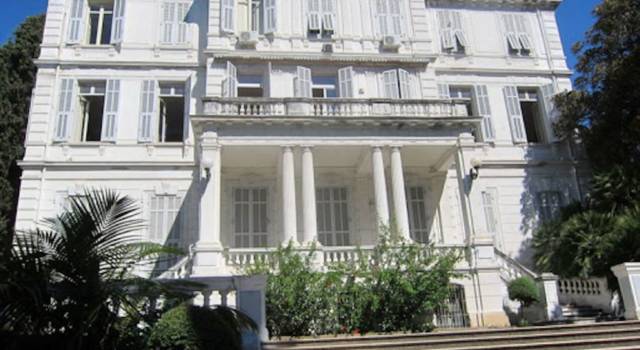The Villa takes its name from the first customer the lawyer Cavalier Giovan Battista Zirio, a banker from Marseilles, who had it built in 1868 to live with his wife Marie Grandval during the stays in his hometown.
The French architect was in charge of the construction Bérengier, who designed a neoclassical building with a double semicircular staircase to reach the central colonnaded loggia, that supports the terrace on the second floor.
The joinery and gas lighting equipment came from France while the decorated marble was made by the sculptor Filippo Ghersi and the Pompeian-style frescoes by two noteworthy Genoese painters: Francesco Semino and Giovanni Novaro.
Currently the villa it hosts some municipal offices and the headquarters of the symphony orchestra and some sumptuous interiors still preserve, some rooms of the noble floor richly frescoed, including the one called “of conversation”, where civil marriages were celebrated in these years. To remember that in the villa the wrought iron elevator No. 2 of the Stigler-Otis company is still functioning, which represented a real jewel of modernity.
At the death of Cavalier Zirio, the widow married the Marquis Agostino Borea d’Olmo and ceded the villa to Senator Ernesto Marsaglia who rented it to what would be his most illustrious guest: the Imperial Prince of Prussia and future Kaiser Frederick William III. At that time Villa Zirio was transformed into a place visited by illustrious people, who paid homage to the illustrious guest like Richard Wagner and the Sultan of Constantinople Abdul Amid, who arrived in the city with 36 wives.
Particularly memorable was the celebration of January 25th 1888 for the silver wedding of the imperial couple, when the city streets and the garden of the villa were lit up by electric arches, colored light bulbs and fireworks.
Frederick William III
The Crown Prince Frederick William, son of Kaiser William I and son-in-law of Queen Victoria of England, arrived in Sanremo on 3 November 1887 with his wife, children and a rich following. He hoped to recover from the laryngeal cancer that tormented him and had not been correctly diagnosed in Germany.
On November 9th of the same year one of the most important doctors in Europe arrived in Sanremo: Sir Morell Mackenzie, personal doctor of Queen Victoria of England, mother of the wife of the illustrious patient. Despite the tracheotomy performed by a team of doctors to improve his breathing, the Prince’s condition progressively deteriorated but not so much as to stop him from having a few pleasant months until the 3rd March 1888, when he was caught up with the news of his father’s death.
He left for Berlin to be crowned as the new Kaiser, he was greeted at the station by a crowd of 5000 citizens who had admired his kindness and sympathy: he reigned unfortunately only 99 days and died in Potsdam on 15th June of the same year. To remember this memorable stay we can still see the plaque written in German by the poet Ernst Won Wilderbruck, located in the garden and visible from the Via Aurelia, which in translation reads: “You who come from Germany stop your step, oh traveler, in this place where your emperor Frederick lived and suffered. Do you hear the wave that beats on the wave and sighs towards the shore? It is the nostalgic soul of Germany that remembers it “.
Garden
The slightly degrading garden of the villa was built by the famous Ludwig Winter, German botanist and landscape architect, designer of plant nurseries and gardens like those in Bordighera and Hanbury in La Mortola.
The park, which generally maintains its original layout was, and partly still is, of great environmental importance with the nearby parks of the Hotel Bellevue in the east and Villa Rothenburg (now Giovanna d’Arco) in the west.
The dominant vegetation is made up of majestic plants such as the very tall Washingtonia palms Robusta and two gigantic specimens of Ficus macrophylla that constitute real living monuments, symbol of the garden and of the villa itself.

